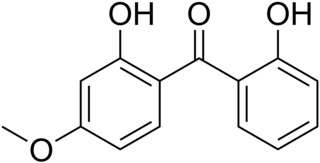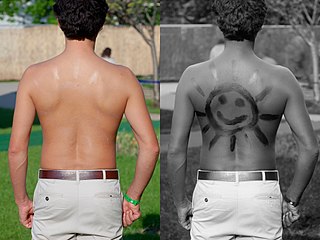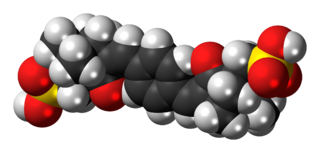
Ultraviolet (UV) is a form of electromagnetic radiation with wavelength from 10 nm to 400 nm, shorter than that of visible light, but longer than X-rays. UV radiation is present in sunlight, and constitutes about 10% of the total electromagnetic radiation output from the Sun. It is also produced by electric arcs and specialized lights, such as mercury-vapor lamps, tanning lamps, and black lights. Although long-wavelength ultraviolet is not considered an ionizing radiation because its photons lack the energy to ionize atoms, it can cause chemical reactions and causes many substances to glow or fluoresce. Consequently, the chemical and biological effects of UV are greater than simple heating effects, and many practical applications of UV radiation derive from its interactions with organic molecules.

Oxybenzone or benzophenone-3 or BP-3 is an organic compound. It is a pale-yellow solid that is readily soluble in most organic solvents. Oxybenzone belongs to the class of aromatic ketones known as benzophenones. It is a naturally occurring chemical found in various flowering plants as well as being an organic component of many sunscreen lotions. It is also in widespread use in things like plastics, toys, furniture finishes, and more to limit UV degradation.

Dioxybenzone (benzophenone-8) is an organic compound used in sunscreen to block UVB and short-wave UVA (ultraviolet) rays. It is a derivative of benzophenone. It is a yellow powder with a melting point of 68 °C. It is insoluble in water, but moderately soluble in ethanol and isopropanol.

Sunscreen, also known as suncream, sunblock or suntan lotion, is a lotion, spray, gel, foam, stick or other topical product that absorbs or reflects some of the sun's ultraviolet (UV) radiation and thus helps protect against sunburn. Diligent use of sunscreen can also help to slow or temporarily prevent the development of wrinkles, dark spots and sagging skin.

A blacklight, also referred to as a UV-A light, Wood's lamp, or ultraviolet light, is a lamp that emits long-wave (UV-A) ultraviolet light and very little visible light.

Sun tanning or simply tanning is the process whereby skin color is darkened or tanned. It is most often a result of exposure to ultraviolet (UV) radiation from sunlight or from artificial sources, such as a tanning lamp found in indoor tanning beds. People who deliberately tan their skin by exposure to the sun engage in a passive recreational activity of sun bathing. Some people use chemical products which can produce a tanning effect without exposure to ultraviolet radiation, known as sunless tanning.

Indoor tanning involves using a device that emits ultraviolet radiation to produce a cosmetic tan. Typically found in tanning salons, gyms, spas, hotels, and sporting facilities, and less often in private residences, the most common device is a horizontal tanning bed, also known as a sunbed or solarium. Vertical devices are known as tanning booths or stand-up sunbeds.
Ultraviolet light therapy or ultraviolet phototherapy is a form of treatment for certain skin disorders including atopic skin disorder and vitiligo when used with psoralen to form the PUVA treatment. It consists of irradiation of the patient with the UVA band of ultraviolet light, usually delivered from a fluorescent bulb specially designed to output this frequency of ultraviolet.
PUVA is an ultraviolet light therapy treatment for skin diseases: eczema, psoriasis, graft-versus-host disease, vitiligo, mycosis fungoides, large plaque parapsoriasis and cutaneous T-cell lymphoma using the sensitizing effects of the drug psoralen. The psoralen is applied or taken orally to sensitize the skin, then the skin is exposed to UVA.

Ecamsule is an organic compound which is added to many sunscreens to filter out UVA rays. It is a benzylidene camphor derivative, many of which are known for their excellent photostability.
Ultraviolet-sensitive beads are beads that are colorful in the presence of ultraviolet radiation. Ultraviolet rays are present in sunlight and light from various artificial sources and can cause sunburn or skin cancer. The color change in the beads alerts the wearer to the presence of the radiation.

Octocrylene is an organic compound used as an ingredient in sunscreens and cosmetics. It is an ester formed by the reaction of 3,3-diphenylcyanoacrylate with 2-ethylhexanol. It is a viscous, oily liquid that is clear and colorless.

Octyl salicylate, or 2-ethylhexyl salicylate, is an organic compound used as an ingredient in sunscreens and cosmetics to absorb UVB (ultraviolet) rays from the sun. It is an ester formed by the condensation of salicylic acid with 2-ethylhexanol. It is a colorless oily liquid with a slight floral odor.
A photochromic lens is an optical lens that darkens on exposure to light of sufficiently high frequency, most commonly ultraviolet (UV) radiation. In the absence of activating light, the lenses return to their clear state. Photochromic lenses may be made of glass, polycarbonate, or another plastic. They are principally used in eyeglasses that are dark in bright sunlight, but clear in low ambient light conditions. They darken significantly within about a minute of exposure to bright light and take somewhat longer to clear. A range of clear and dark transmittances is available.

Tanning lamps are the part of a tanning bed, booth or other tanning device which produces ultraviolet light responsible for indoor tanning. There are hundreds of different kinds of tanning lamps most of which can be classified in two basic groups: low pressure and high pressure. Within the industry, it is common to call high-pressure units "bulbs" and low-pressure units "lamps", although there are many exceptions and not everyone follows this example. This is likely due to the size of the unit, rather than the type. Both types require an oxygen free environment inside the lamp.

Bisoctrizole is a phenolic benzotriazole that is added to sunscreens to absorb UV rays.
Helioplex is a formulation of broad-spectrum ultraviolet skin protection containing avobenzone and oxybenzone made by Neutrogena.
UV-B lamps are lamps that emit a spectrum of ultraviolet light with wavelengths ranging from 290–320 nanometers. This spectrum is also commonly called the biological spectrum due to the human body's sensitivity to light of such a wavelength. UV-B light does not tan the skin very much, compared to the UV-A lamps that are used in tanning beds.

Benzphenone-1 – benzophenone-12 are UVA/UVB absorbers. Some of them are used in sunscreens.

The ultraviolet radiation in sunlight has both positive and negative health effects, as it is required for the synthesis of vitamin D3 and is a mutagen. A dietary supplement can supply vitamin D without this mutagenic effect. Vitamin D has been suggested as having a wide range of positive health effects, which include strengthening bones and possibly inhibiting the growth of some cancers. UV exposure also has positive effects for endorphin levels, and possibly for protection against multiple sclerosis. Visible sunlight to the eyes gives health benefits through its association with the timing of melatonin synthesis, maintenance of normal and robust circadian rhythms, and reduced risk of seasonal affective disorder.















